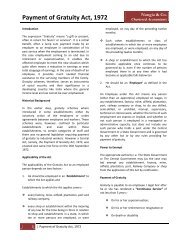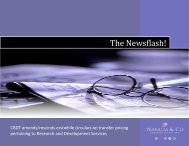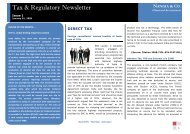DIRECT TAX - Nangia & Co
DIRECT TAX - Nangia & Co
DIRECT TAX - Nangia & Co
Create successful ePaper yourself
Turn your PDF publications into a flip-book with our unique Google optimized e-Paper software.
Tax & Regulatory Newsletter<br />
Issue 05 – AUGUST, 2010<br />
NANGIA & CO.<br />
Chartered Accountants<br />
New Delhi – Mumbai - Dehradun<br />
services directly to its clients whereas the IPS article of the UK Treaty<br />
extended only to individuals and, hence, it could not be applied to a<br />
partnership like the taxpayer.<br />
The Assessing Officer rejected<br />
the taxpayer’s arguments and<br />
concluded that it had a PE in<br />
India under the Services PE rule<br />
and proceeded to tax its entire<br />
Income in relation to India projects (including services rendered from<br />
the UK office) on the basis of actual revenues received. On appeal,<br />
the first appellate authority agreed with the Assessing Officer on the<br />
existence of the PE but restricted taxation to the extent of services<br />
rendered in India.<br />
Upon appeal by both sides the Income Tax Appellate Tribunal ruled<br />
that –<br />
Though a UK partnership was a “person” under Article 3(2), the<br />
question whether it was a “resident of UK” was of question.<br />
Article 4(1) defined a “resident of a <strong>Co</strong>ntracting State” to mean a<br />
person “liable to tax in that State by reasons of domicile,<br />
residence, place of management or any other criterion of similar<br />
nature”. Also, according to the OECD Report on Partnerships,<br />
mere computation of income at the level of partnership was not<br />
sufficient to hold that the partnership firm was ‘liable to taxation’<br />
in the residence country, however, this view was not correct and<br />
had also been rejected by India. A partnership was eligible to the<br />
benefits of the DTAA provided the entire profits of the firm were<br />
taxed in UK whether in the hands of the firm or in the hands of<br />
the partners directly;<br />
The Service PE formed part of the second category of the two<br />
heterogeneous categories of PE in the Indo-UK tax treaty which<br />
consisted of extensions of the basic PE rule and deemed PEs and<br />
hence did not need to satisfy the requirement of a Basic PE rule.<br />
Also, the term ‘rendering’ and ‘furnishing’ were interchangeably<br />
used and the term furnishing could not exclude the rendering of<br />
professional service directly to clients as suggested by the<br />
taxpayer;<br />
The IPS article of the UK Treaty could not be applied as it related<br />
to performance of services by individuals;<br />
As regards the quantum of profits attributable to the PE, the<br />
argument that by virtue of Article 7(2), the PE must be assessed<br />
by taking the value of services rendered by the PE at the market<br />
value of such services in India and not the price at which the<br />
taxpayer billed its clients was not acceptable. The fiction of<br />
hypothetical independence in Article 7(2) was confined to a PE’s<br />
transactions with its head office and branches and did not extend<br />
to transactions with third parties. The arms length principle in<br />
Page | 8









